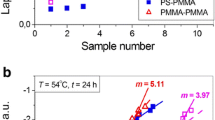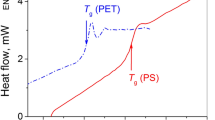Abstract
For the first time, the strength distribution upon the bonding onset between the contacting glassy polymer samples has been analysed by employing the Weibull statistics. It has been found that the distribution of the lap-shear strength (σ) developed between the contacting pieces of such representative amorphous polymers as atactic polystyrene (PS) and poly(methyl methacrylate) (PMMA) at the time-temperature healing conditions at which the interface bonding starts follows the Weibull distribution function. It has been shown that the σ distributions for the compatible PS-PS and PMMA-PMMA and incompatible PS-PMMA interfaces are not affected by the factor of thermodynamic compatibility of the PS and PMMA segments. The estimated values of the Weibull modulus m and of the scale parameter σ 0 for the weak polymer-polymer interfaces investigated have been compared with those estimated for the tensile strengths of the PS and PMMA monolithic bulk samples which were used for the interface healing experiments and of the ultra-high-strength inorganic quasi-brittle materials reported in the literature.






Similar content being viewed by others
References
Boiko YM, Prud’homme RE (1997) Bonding at symmetric polymer/polymer interfaces below the glass transition temperature. Macromolecules 30:3708–3710. doi:10.1021/ma960002x
Boiko YM, Lyngaae-Jørgensen J (2004) Bonding at compatible and incompatible amorphous interfaces of polystyrene and poly(methyl methacrylate) below the glass transition temperature. J Macromol Sci Phys 43:695–709. doi:10.1081/MB-120030015
Boiko YM (2013) Is adhesion between amorphous polymers sensitive to the bulk glass transition? Colloid Polym Sci 291:2259–2262. doi:10.1007/s00396-013-2958-1
Boiko YM, Prud’homme RE (1998) Morphology of fractured polymer surfaces self-bonded below the glass transition temperature. Mech Compos Mater 34:473–482. doi:10.1007/BF02254711
Boiko YM, Lyngaae-Jørgensen J (2004) Auto-adhesion of high-molecular-weight monodisperse glassy polystyrene at unexpectedly low temperatures. J Macromol Sci Part B Phys B43:925–934. doi:10.1081/MB-200033257
Zhang X, Tasaka S, Inagaki N (2000) Surface mechanical properties of low-molecular-weight polystyrene below its glass-transition temperatures. J Polym Sci Part B Polym Phys 38:654–658. doi:10.1002/(SICI)1099-0488(20000301)
Boiko YM, Lyngaae-Jørgensen J (2005) A phenomenon of the auto-adhesion of high-molecular-weight polystyrene and poly(methyl methacrylate) at room temperature. Polym Sci B 47:867–870
Boiko YM (2016) On the molecular mechanism of self-healing of glassy polymers. Colloid Polym Sci 294:1237–1242. doi:10.1007/s00396-016-3868-9
Boiko YM (2011) Interdiffusion of polymers with glassy bulk. Colloid Polym Sci 289:1847–1854. doi:10.1007/s00396-011-2508-7
Boiko YM, Prud’homme RE (1999) Mechanical properties developing at the interface of amorphous miscible polymers, below the glass transition temperature: time-temperature superposition. J Appl Polym Sci 74:825–830. doi:10.1002/(SICI)1097-4628(19991024)
Boiko YM, Lyngaae-Jørgensen J (2004) Healing of interfaces of high- and ultra-high-molecular-weight polystyrene below the glass transition temperature of the bulk. Polymer 45:8541–8549. doi:10.1016/j.polymer.2004.10.021
Voyutskii SS (1963) Autoadhesion and adhesion of high polymers. Interscience, New York
Wool RP (1995) Polymer interfaces: structure and strength. Hanser Press, Munich
Kajiyama T, Tanaka K, Takahara A (1995) Depth dependence of the surface glass transition temperature of a poly(styrene-block-methyl methacrylate) diblock copolymer film on the basis of temperature-dependent X-ray photoelectron spectroscopy. Macromolecules 28:3482–3484. doi:10.1021/ma00113a059
Mansfield KF, Theodorou DN (1991) Molecular dynamics simulation of a glassy polymer surface. Macromolecules 24:6283–6294. doi:10.1021/ma00023a034
Meyers GF, DeCoven BM, Seitz JT (1992) Is the molecular surface of polystyrene really glassy? Langmuir 8:2330–2335. doi:10.1021/la00045a042
Boiko YM (2010) New simple method of measuring the surface glass transition temperature of polymers. J Polym Sci Part B Polym Phys 48:2012–2021. doi:10.1002/polb.22081
Tanaka F, Okabe T, Okuda H, Kinloch IA, Young RJ (2014) Factors controlling the strength of carbon fibres in tension. Composites Part A 57:88–94. doi:10.1016/jcompositesa.2013.11.007
Baikova LG, Pesina TI, Kireenko MF, Tikhonova LV, Kurkjian CR (2015) Strength of optical silica fibers measured in liquid nitrogen. Tech Phys 60:869–872. doi:10.1134/S1063784215060031
Wilson DM (1997) Statistical tensile strength of Nextel™ 610 and Nextel™ 720 fibres. J Mater Sci 32:2535–2542. doi:10.1023/A:1018538030985
Weibull W (1951) A statistical distribution function of wide applicability. J Appl Mech 18:293–297
Foster KL, Wool RP (1991) Strength of polystyrene-poly(methyl methacrylate) interfaces. Macromolecules 24:1397–1403. doi:10.1021/ma00006a028
Willett JL, Wool RP (1993) Strength of incompatible amorphous polymer interfaces. Macromolecules 26:5336–5349. doi:10.1021/ma00072a010
Barber AH, Andrews R, Shaudler LS, Wagner HD (2005) On the tensile strength distribution of multiwalled carbon nanotubes. Appl Phys Lett 87:203106. doi:10.1063/1.2130713
Sullivan JD, Lauzon PH (1986) Experimental probability estimators for Weibull plots. J Mater Sci Lett 5:1245–1247. doi:10.1007/BF01729379
Gurvich MR, Dibenedetto AT, Pegoretti A (1997) Evaluation of the statistical parameters of a Weibull distribution. J Mater Sci 32:3711–3716. doi:10.1023/A:1018603118573
Sun G, Pang JHL, Zhou J, Zhang Y, Zhan Z, Zheng L (2012) A modified Weibull model for tensile strength distribution of carbon nanotube fibers with strain rate and size effects. Appl Phys Lett 101:131905. doi:10.1063/1.4754709
Acknowledgments
This work was supported in part by the Federal Agency of Scientific Organisations of the Russian Federation.
Author information
Authors and Affiliations
Corresponding author
Ethics declarations
Conflict of interest
The author declares that he has no conflict of interest.
Rights and permissions
About this article
Cite this article
Boiko, Y.M. Statistics of strength distribution upon the start of adhesion between glassy polymers. Colloid Polym Sci 294, 1727–1732 (2016). https://doi.org/10.1007/s00396-016-3934-3
Received:
Revised:
Accepted:
Published:
Issue Date:
DOI: https://doi.org/10.1007/s00396-016-3934-3




